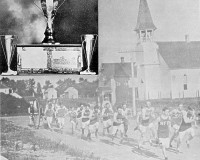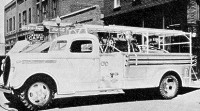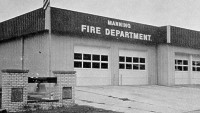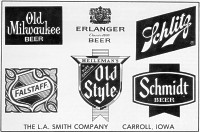

FIRE DEPARTMENT
Fighting fires in Manning's first few years was not a very efficient process. Those who wanted to pitch in could fill a bucket at the nearest well or cistern, then toss the water on the flames. According to early accounts, there was no bucket brigade or any form of organized fire fighting methods.
In September, 1883, the town council approved a $1,000 bond for fire protection, and in May, 1884, a meeting was called to organize a hose company. Members were president N.J. Smith, vice-president J.M. Nettle, foreman F.W. Arney, assistant foreman W.P. Guild, secretary Neil McArthur, treasurer G.F. Chapman, trustees E.C. Perry, A.L. Wright, C.S. Lawrence, and members R.L. Zane, J.B. Henshaw, D.D. Clark, W.F. Carpenter, C. Johnson, E. Smith and F. Wilkins.
A hose and cart were purchased in August, 1884, which included 600 feet of 2 1/2 inch hose, three 36 inch brass swirl handles, one set of coupling tools, one hydrant gate, and a 18 foot blade on a windmill tower to supply water. A 30 foot tall water tower holding 50,000 gallons was completed on Christmas Day, and in January, a 16 by 20 foot hose cart house was built on Third Street next to the water tower. The water works system had cost $4,832, and the building was $105.
Purchases in 1885 included two hooks, sufficient rope and chain, two axes, and two lanterns, with six fire ladders being donated. Funds for the hose company were raised through Firemen's Dances, which for a time were held the first Thursday night of each month.
The first fire bell, which weighed 400 pounds and cost $125, was purchased in June, 1891.
July 9, 1891, the town of Manning purchased the Manning Hose Company's interest in the fire fighting equipment and the cart house for $175, and the Manning Fire Department assumed its name.
During the next three years, the town's water supply became less and less adequate. The reservoir, which was sunk south of the present American Legion Building, was supposed to supply filtered water from the creek, but high water often flooded the reservoir and filled it with sediment and impure water. A well was then dug east of the reservoir, but failed to supply enough water in the dry years of 1893-94. In 1894, nine three-inch sand wells were sunk and connected with the pumping station, which was converted from wind power to steam power at that time.
A mile of 6 and 4 inch water mains were laid, with 14 double fire plugs connected to the mains. By then, the fire department had 1500 feet of hose, three carts to wheel the hose, and a hook and ladder truck equipped with ladders, buckets and other appliances. This combination of an improved water system and additional fire fighting equipment provided Manning with the best of service available.
CHAMPION RUNNING TEAM
The equipment was pulled by hand, and, many long hours were spent in training. Speed and coordination were the key to getting to a fire as fast as possible, and the men were assigned to certain positions, such as those at the pole, at the lead, and who would work the rope, the reel and
Continued from 23
do the coupling.
Teams from around the state held annual tournaments, competing in straight away races, running coupling, a chief's race, leader's race, and hub-and-hub races, which were usually held between the two fastest teams.
In the state races at Perry in July, 1913, Manning's running team won the state cup for the third time and lowered two previous marks, setting a new world's record. The cup was permanently awarded to the Manning Fire Department.
The team included John Rostermundt, P.H. Jones, Herman Goettsch, Ray McMillian, Hugo Grundmeier, Ernest Grundmeier, August Gruhn, Frank Mantz, Joe Rusenberg, Art Goettsch, R.H. Wheeler, Otto Kempf, Flemming, Chas. McLaughlin, Harry Hoffmann, Louie Reinhold, Williams, and George Dethlefs. The training squad also included Russell Free, J. Schoening, Summerfeldt, and Wm. Dillingham. Intense training sessions had been conducted by Dr. J.J. Miller, Frank Hoffmann, R.H. Wheeler, Frank J. Mantz, and Captain Gruhn, and an automobile was used to pull the cart the last two weeks of training to give the couplers additional practice.

MOTORIZED EQUIPMENT
The first motorized firefighting equipment was a Nash purchased in 1923. A city ordinance was passed the following year giving fire fighting equipment the right-of-way going to and coming from fires; violators could be fined up to $100 or sentenced to 30 days in jail.
A large American LaFrance truck was purchased in 1925 and delivered in June, 1928. As the years passed, the unit was renovated and was still used to fight fires in the 1960's. In 1980, the LaFrance was repainted, the chrome replated, and the truck began representing Manning in area parades.
The first group meeting of rural and city firemen was held in 1939 to raise money for a new farm fire truck, which was to have a 300 gallon capacity. A second farm truck was purchased in 1952; it had a 1953 chassis and a 500 gallon water supply. A portable respirator and a portable pump were also purchased in 1952.
To aid in fighting rural fires, a portable holding tank was built by the firemen about 20 years ago. The tank, which has been since replaced by a ready-made model, enabled the tankers to dump the water and return to town for additional supplies.
In 1954, an emergency unit consisting of a portable generator and Scott Air Pak was purchased, and through the efforts of the Chamber of Commerce and the rural fire truck committees, a new 1,000 gallon tanker was acquired in 1955.
Other new trucks were purchased in 1962 and 1971, a tanker in 1978 and a rescue unit in 1975. The old rescue unit was donated to the Gray fire department at that time. The department purchased radio units for the members' homes in 1970, so alerts could be issued more efficiently.
When the Ford Garage at the corner of Third and Center Streets was built in 1919, room in the rear of the basement was used to store the fire department's equipment. Several years later, the department was given a building on the east side of Main Street, donated by cigar-maker Paul Moerke in gratitude for the firemen's efforts in saving the building in a 1916 fire next door.
The fire department moved to the north side of Highway 141 after the station on Main Street was destroyed by a fire in April, 1953. Their new brick building, which had four vehicle stalls, was adjacent to the Opera House, then owned by the Schuetzen Verein. When the verein decided to sell the hall, the firemen purchased it and held dances, banquets, and other social functions there for many years. In 1959, the building, then known as the Firemen's Hall, became a classroom for the expanding school district. The construction of the new school building and the decreased need for the hall forced its razing in 1975.
An addition to the fire station was dedicated in 1976. The 60 x 80 foot structure has room for five vehicles, a conference room and kitchen. The monument at the front of the building includes the cornerstone from the original Schuetzen Hall, built in 1882 and destroyed in a 1925 fire, the cornerstone from the second hall built in 1925, and the original fire bell which was used until the :930's.
Ambulance service for the Manning area came under the auspices of the fire department January 1, 1974. Although the city took charge of the local service in 1976, the county-owned ambulance is still housed at the fire station and many of its drivers and technicians are also members of the fire department.
Manning firemen also answer rescue calls, with

Continued from 24
their emergency unit receiving a "Jaws of Life" in 1979. Donations for this $5,400 piece of equipment were made by a number of organizations, and the Jaws have already been used numerous times to free victims trapped inside vehicles.
The firemen have been called to remove rats from kitchens, rescue cats in trees, and guide small children through the bewildering excitement of Children's Day parades.
As of 1980, the department has 36 members who volunteer their time for the average 25 calls per year and the 1000 hours of training held yearly.
Officers this year are: President Barry Kusel, Vice-President Ron Halbur, Secretary Tom Williams, Treasurer Daryl Genzen, Trustees Donald (Bonnie) Joens, John Ohde and David Rauch, and Hall Committee members Lyle Rowedder, Dean Vollstedt, Larry Hansen, Delbert Vinke, and Joe Knueven. Merlyn Irlbeck is the Chief, Wayne Schroeder is the Assistant Chief, and Captains are Larry Hansen, Lyle Rowedder and Dean Vollstedt.
At the present time the department has eight units.
